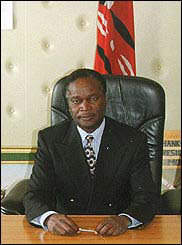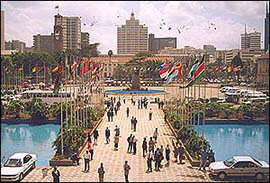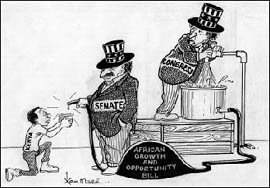 THE FUTURE LAYS IN THE REGION: E.A.C. AND COMESA THE FUTURE LAYS IN THE REGION: E.A.C. AND COMESA |
Not only the future of capital markets lays in the region. Trade, tourism and industry heavily depend on regional ties. In fact, Kenya, Uganda and Tanzania used to be the East African Community, with common infrastructures, airlines, railways and even currency. When dictator Idi Amin took over power in Uganda, and Tanzania turned to communism, the E.A. Community got dissolved, considerably hurting Kenyan economy and businesses. In spite of it, Kenya continued growing while its two neighbors stagnated. In 1996 the old dream was revived through the establishment of the Tripartite Commission for East African Cooperation (EAC). The EAC, unlike its predecessor, does not exercise control over all areas of government. Rather, it proposes the elimination of trade barriers, free movement of their citizens, the harmonization of transport, security, and fiscal and monetary policies. In fact, what it tries to achieve is an economic federation of independent states. By November 1999 the Treaty will be signed, signifying 0 tariffs for inter-regional trade.

So far , according to the ever powerful Hon. Biwott, former Minister of East African and Regional Cooperation, labeled the Total-man, by the local press, EAC is pursuing a number of programs that aim to unify and harmonize the their telecommunications systems. The most advanced ones include the E.A. Roads Network Program, which intends to link and improve the three countries road system - Uganda is land-locked and desperately needs access to the sea -, the extension of the oil pipeline to Uganda and a number of other projects aiming to save the rapidly deteriorating Lake Victoria, common to all three neighbors.
However, even though the establishment of the EAC is already opening up market opportunities for Kenya, the real future lies in COMESA, the Common Market for Eastern and Southern Africa.
 COMESA, A 400 MILLION PEOPLE MARKET COMESA, A 400 MILLION PEOPLE MARKET |
Map of COMESA
Nairobi hosted in May 1999 the COMESA summit, receiving 11 heads of state of its 21 member countries (Angola, Burundi, Comoros, Democratic Republic of Congo, Djibouti, Egypt, Eritrea, Kenya, Kenya, Madagascar, Malawi, Mauritius, Namibia, Rwanda, Seychelles, Sudan, Swaziland, Tanzania, Uganda, Zambia and Zimbabwe). This organization was created as a counterbalance of SADC (Southern African Development Community), clearly dominated by South Africa. Its aim is to obtain a free common market for all these countries, eliminating inter-state trade tariff barriers by October 2000. Like EAC, it also wants to bring about trade liberalization, transport and trade facilitation, and the free movement of capital. So far the results seem quite positive. Trade among member states rose from US$ 2.8 billion in 1996 to US$ 4.2 in 1998. Kenya clearly benefits from its membership to COMESA. Its exports to this region accounted for 44.4% of its total exports in 1998 (2% higher than in 1997). Tanzania and Uganda, Kenya's main trading partners, absorbed 67% of its exports to the COMESA region.
Kenya, one of the stronger members of COMESA is deeply committed to make it work. In the May 99 Summit in Nairobi, President Moi was unanimously chosen by to preside over the organization, bringing it to the 21st century, through the completion of the zero tariff process. However, the economic and development differences among the member countries are considerable, and a few of them fear economic cannibalism by the stronger ones once the tariffs have been dismantled and they are forced to allow stronger and more competitive companies than their own in their territory.
Hon.
Biwott, ex-Minister
of Eastern African Cooperation, present Minister
of Industry, Tourism and Trade, confesses that "there
is a need for COMESA as a group to devise a mechanism
which will facilitate a system which will allow
the less fortunate member countries access to the
beneficial flow of capital for investment or services".
For this reason, in one of its latest meetings in
Lusaka (Zambia), the summit decided on the creation
of the COMESA Investment Agency to invest in the
region. There has also been a progressive elimination
of tariffs depending on the level of development
of the countries. As of July 1999 only 4 countries
had published a 90% reduction. 7 countries had not
implemented any kind of reduction, and the rest
fell in between. It will take longer than expected,
and the results are yet to be seen. Some of COMESA
members, such as Mozambique and Lesotho already
pulled out in the past, claiming they wanted to
concentrate on SADC. Tanzania has just recently
given formal notice that they want to step out as
well, arguing that they would rather center in East
Africa Cooperation. However the entry of new and
more developed members, such as Egypt, have brought
new vitality to the process, opening new markets
and possibilities. |

 COMESATEX COMESATEX |
"A recent study, carried out by USAID, showed that within COMESA there are over 600 products produced inside the region, but they are currently being imported by some of the member states from third countries such as China, Europe or Far Eastern countries", remarks Mr. Owango, Chairman of the National Chamber of Commerce. For this reason, alongside the Summit of Presidents, the Chamber of Commerce organized COMESATEX, a trade exhibition opened to all member states. "It is only through exhibitions that we can match what exists in the region to what the economies of our countries need".
 TRADE IN AFRICA, TRADE WITH THE WEST TRADE IN AFRICA, TRADE WITH THE WEST |
Indeed, the main market for Kenyan products are still African countries receiving 47% of Kenyan goods. However, while exports to South Africa continued decreasing (Ksh 940 mill in 1998 as opposed to Ksh 2,380 mill 1996), imports from that country amounted, in 1998, to 83% of all Kenyan imports from African countries. What is shocking is that South Africa is not a member of COMESA!. Furthermore, there have been accusations, especially from the Federation of Kenyan Manufacturers, that South Africa was dumping the Kenyan market.

The second largest area for Kenyan exports is the EU (30%). Except to the UK, exports to the European Union decreased 2.6% in 1998. Exports to the USA have dwindled, being in the region of Ksh 3,060 mill (41 US$ mill) in 1998 compared to Ksh 3,400 mill (US$ 45 mill) in 1997. Imports from the USA have, on the other hand, continued rising, more than duplicating their value between 1994 and 1998 (Ksh 16,500 million - US$ 220 mill - in 1998 vs. Ksh 7,620 mill - US$ 101 mill - in 1994), representing 8% of total imports. Sales to the USA are but a drop in the ocean, a mere 2% of total exports. There are a few projects aiming to increase trade between Kenya and the United States. President Clinton's Africa Growth and Opportunity Bill aims at bringing down trade barriers between the USA and the African continent. Having been approved by the American Congress, it has been stopped at the Senate. Once it is approved, it will avail over US$ 650 million for joint ventures and businesses in Sub-Saharan Africa. So far, most Kenyan firms have not fully explored the potential of the American market, claiming that it is too far away and that they do not consider themselves price-competitive. Nonetheless, there are number of firms, notably in the industrial sector, that do seem ready and eager to compete in international markets, at all levels. |

